
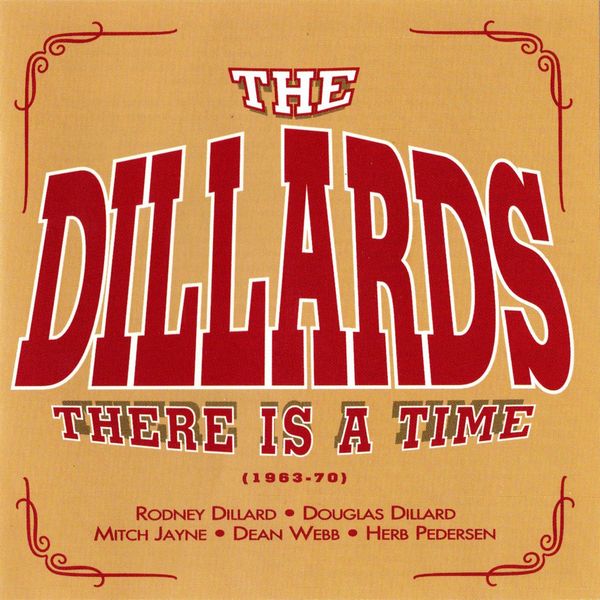 |
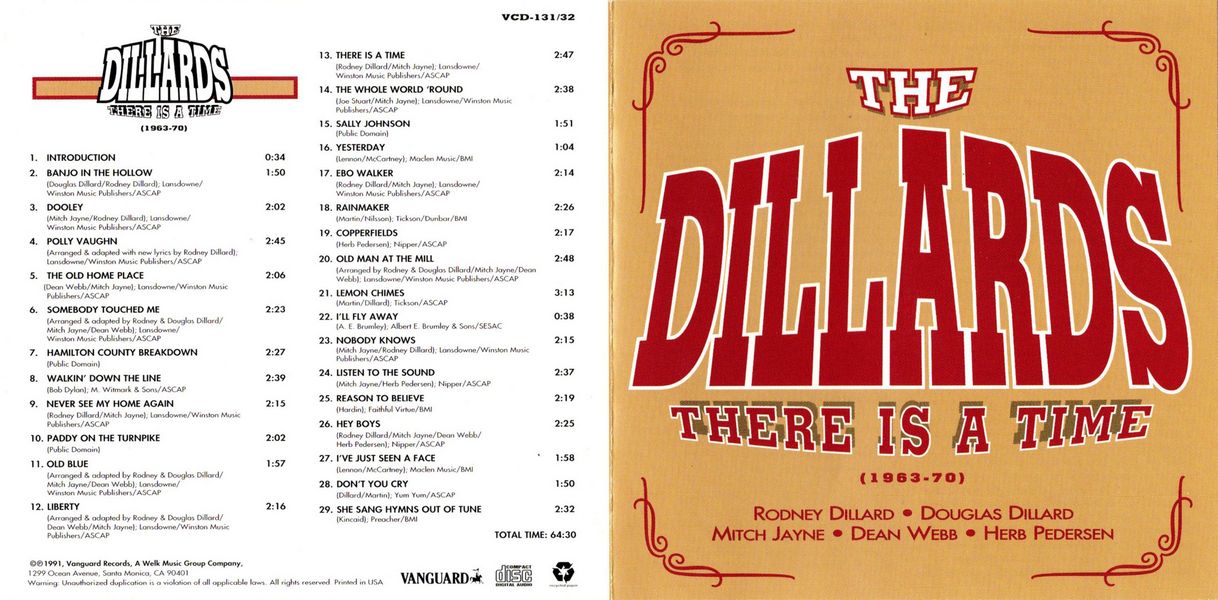
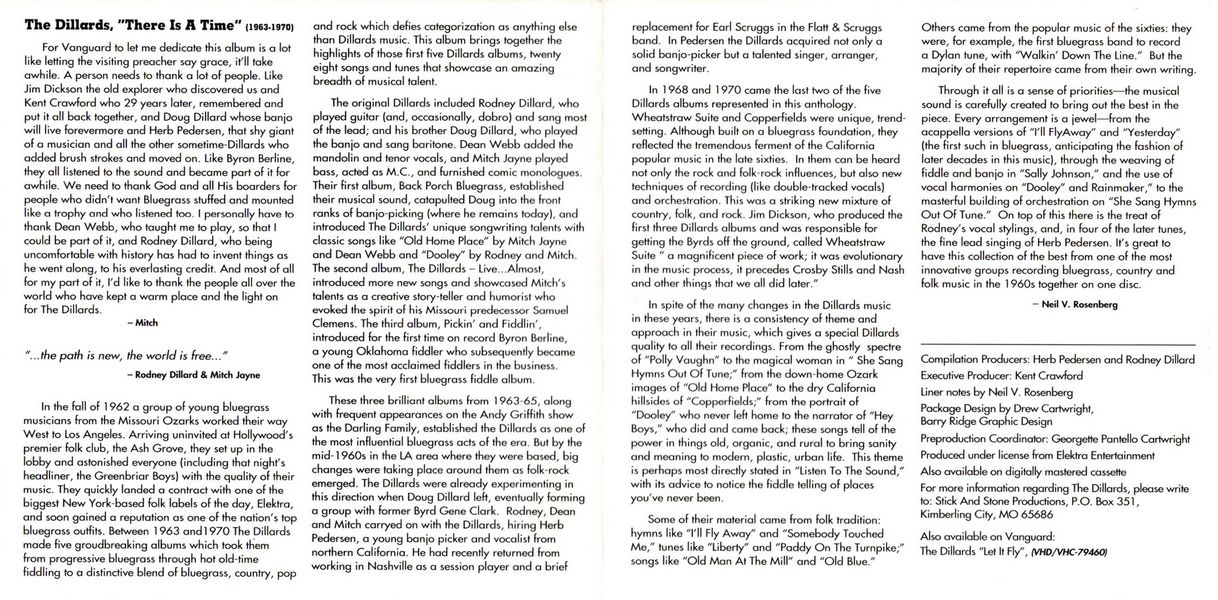 |
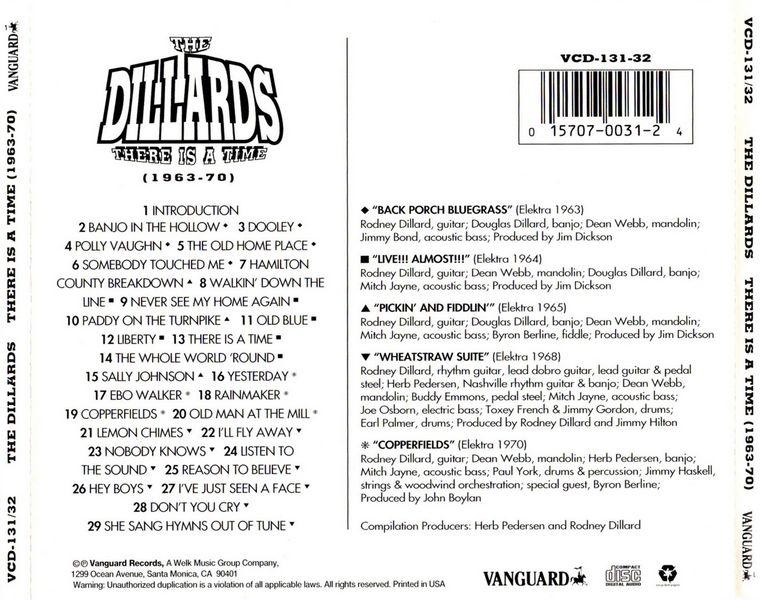
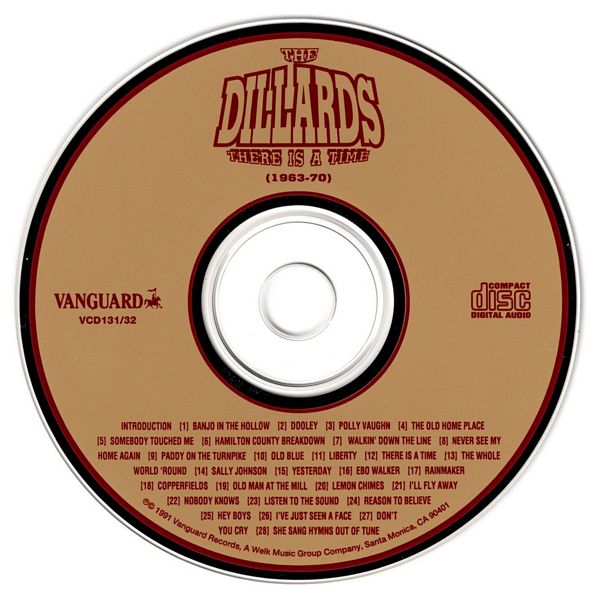 |
Sleeves Notes
For Vanguard to let me dedicate this album is a lot like letting the visiting preacher say grace, it'll take awhile. A person needs to thank a lot of people. Like Jim Dickson the old explorer who discovered us and Kent Crawford who 29 years later, remembered and put it all back together, and Doug Dillard whose banjo will live forevermore and Herb Pedersen, that shy giant of a musician and all the other sometime-Dillards who added brush strokes and moved on. Like Byron Berline, they all listened to the sound and became part of it for awhile. We need to thank God and all His boarders for people who didn't want Bluegrass stuffed and mounted like a trophy and who listened too. I personally have to thank Dean Webb, who taught me to play, so that I could be part of it, and Rodney Dillard, who being uncomfortable with history has had to invent things as he went along, to his everlasting credit. And most of all for my part of it, I'd like to thank the people all over the world who have kept a warm place and the light on for The Dillards.
Mitch
" … the path is new, the world is free … "
Rodney Dillard & Mitch Jayne
In the fall of 1962 a group of young bluegrass musicians from the Missouri Ozarks worked their way West to Los Angeles. Arriving uninvited at Hollywood's premier folk club, the Ash Grove, they set up in the lobby and astonished everyone (including that night's headliner, the Greenbriar Boys) with the quality of their music. They quickly landed a contract with one of the biggest New York-based folk labels of the day, Elektra, and soon gained a reputation as one of the nation's top bluegrass outfits. Between 1963 and 1970 The Dillards made five groudbreaking albums which took them from progressive bluegrass through hot old-time fiddling to a distinctive blend of bluegrass, country, pop and rock which defies categorization as anything else than Dillards music. This album brings together the highlights of those first five Dillards albums, twenty eight songs and tunes that showcase an amazing breadth of musical talent.
The original Dillards included Rodney Dillard, who played guitar (and, occasionally, dobro) and sang most of the lead; and his brother Doug Dillard, who played the banjo and sang baritone. Dean Webb added the mandolin and tenor vocals, and Mitch Jayne played bass, acted as M.C., and furnished comic monologues. Their first album, Back Porch Bluegrass, established their musical sound, catapulted Doug into the front ranks of banjo-picking (where he remains today), and introduced The Dillards' unique songwriting talents with classic songs like "Old Home Place" by Mitch Jayne and Dean Webb and "Dooley" by Rodney and Mitch. The second album, The Dillards — Live … Almost, introduced more new songs and showcased Mitch's talents as a creative story-teller and humorist who evoked the spirit of his Missouri predecessor Samuel Clemens. The third album, Pickin' and Fiddlin', introduced for the first time on record Byron Berline, a young Oklahoma fiddler who subsequently became one of the most acclaimed fiddlers in the business. This was the very first bluegrass fiddle album.
These three brilliant albums from 1963-65, along with frequent appearances on the Andy Griffith show as the Darling Family, established the Dillards as one of the most influential bluegrass acts of the era. But by the mid-1960s in the LA area where they were based, big changes were taking place around them as folk-rock emerged. The Dillards were already experimenting in this direction when Doug Dillard left, eventually forming a group with former Byrd Gene Clark. Rodney, Dean and Mitch carried on with the Dillards, hiring Herb Pedersen, a young banjo picker and vocalist from northern California. He had recently returned from working in Nashville as a session player and a brief replacement for Earl Scruggs in the Flatt & Scruggs band. In Pedersen the Dillards acquired not only a solid banjo-picker but a talented singer, arranger, and songwriter.
In 1968 and 1970 came the last two of the five Dillards albums represented in this anthology. Wheatstraw Suite and Copperfields were unique, trendsetting. Although built on a bluegrass foundation, they reflected the tremendous ferment of the California popular music in the late sixties. In them can be heard not only the rock and folk-rock influences, but also new techniques of recording (like double-tracked vocals) and orchestration. This was a striking new mixture of country, folk, and rock. Jim Dickson, who produced the first three Dillards albums and was responsible for getting the Byrds off the ground, called Wheatstraw Suite" a magnificent piece of work; it was evolutionary in the music process, it precedes Crosby Stills and Nash and other things that we all did later."
In spite of the many changes in the Dillards music in these years, there is a consistency of theme and approach in their music, which gives a special Dillards quality to all their recordings. From the ghostly spectre of "Polly Vaughn" to the magical woman in "She Sang Hymns Out Of Tune," from the down-home Ozark images of "Old Home Place" to the dry California hillsides of "Copperfields," from the portrait of "Dooley" who never left home to the narrator of "Hey Boys," who did and came back; these songs tell of the power in things old, organic, and rural to bring sanity and meaning to modern, plastic, urban life. This theme is perhaps most directly stated in "Listen To The Sound," with its advice to notice the fiddle telling of places you've never been.
Some of their material came from folk tradition: hymns like "I'll Fly Away" and "Somebody Touched Me," tunes like "Liberty" and "Paddy On The Turnpike," songs like "Old Man At The Mill" and "Old Blue."
Others came from the popular music of the sixties: they were, for example, the first bluegrass band to record a Dylan tune, with "Walkin' Down The Line." But the majority of their repertoire came from their own writing.
Through it all is a sense of priorities—the musical sound is carefully created to bring out the best in the piece. Every arrangement is a jewel—from the acappella versions of "I'll FlyAway" and "Yesterday" (the first such in bluegrass, anticipating the fashion of later decades in this music), through the weaving of fiddle and banjo in "Sally Johnson," and the use of vocal harmonies on "Dooley" and Rainmaker," to the masterful building of orchestration on "She Sang Hymns Out Of Tune." On top of this there is the treat of Rodney's vocal stylings, and, in four of the later tunes, the fine lead singing of Herb Pedersen. It's great to have this collection of the best from one of the most innovative groups recording bluegrass, country and folk music in the 1960s together on one disc.
Neil V. Rosenberg